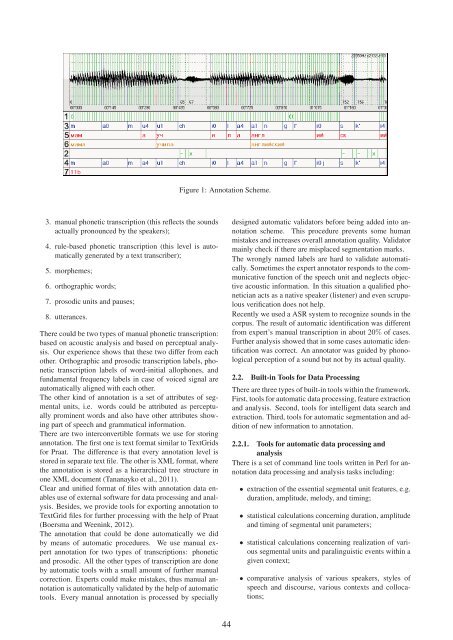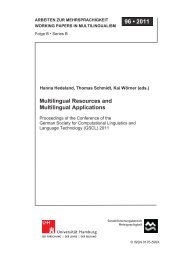Best Practices for Speech Corpora in Linguistic Research Workshop ...
Best Practices for Speech Corpora in Linguistic Research Workshop ...
Best Practices for Speech Corpora in Linguistic Research Workshop ...
Create successful ePaper yourself
Turn your PDF publications into a flip-book with our unique Google optimized e-Paper software.
3. manual phonetic transcription (this reflects the sounds<br />
actually pronounced by the speakers);<br />
4. rule-based phonetic transcription (this level is automatically<br />
generated by a text transcriber);<br />
5. morphemes;<br />
6. orthographic words;<br />
7. prosodic units and pauses;<br />
8. utterances.<br />
There could be two types of manual phonetic transcription:<br />
based on acoustic analysis and based on perceptual analysis.<br />
Our experience shows that these two differ from each<br />
other. Orthographic and prosodic transcription labels, phonetic<br />
transcription labels of word-<strong>in</strong>itial allophones, and<br />
fundamental frequency labels <strong>in</strong> case of voiced signal are<br />
automatically aligned with each other.<br />
The other k<strong>in</strong>d of annotation is a set of attributes of segmental<br />
units, i.e. words could be attributed as perceptually<br />
prom<strong>in</strong>ent words and also have other attributes show<strong>in</strong>g<br />
part of speech and grammatical <strong>in</strong><strong>for</strong>mation.<br />
There are two <strong>in</strong>terconvertible <strong>for</strong>mats we use <strong>for</strong> stor<strong>in</strong>g<br />
annotation. The first one is text <strong>for</strong>mat similar to TextGrids<br />
<strong>for</strong> Praat. The difference is that every annotation level is<br />
stored <strong>in</strong> separate text file. The other is XML <strong>for</strong>mat, where<br />
the annotation is stored as a hierarchical tree structure <strong>in</strong><br />
one XML document (Tananayko et al., 2011).<br />
Clear and unified <strong>for</strong>mat of files with annotation data enables<br />
use of external software <strong>for</strong> data process<strong>in</strong>g and analysis.<br />
Besides, we provide tools <strong>for</strong> export<strong>in</strong>g annotation to<br />
TextGrid files <strong>for</strong> further process<strong>in</strong>g with the help of Praat<br />
(Boersma and Ween<strong>in</strong>k, 2012).<br />
The annotation that could be done automatically we did<br />
by means of automatic procedures. We use manual expert<br />
annotation <strong>for</strong> two types of transcriptions: phonetic<br />
and prosodic. All the other types of transcription are done<br />
by automatic tools with a small amount of further manual<br />
correction. Experts could make mistakes, thus manual annotation<br />
is automatically validated by the help of automatic<br />
tools. Every manual annotation is processed by specially<br />
Figure 1: Annotation Scheme.<br />
44<br />
designed automatic validators be<strong>for</strong>e be<strong>in</strong>g added <strong>in</strong>to annotation<br />
scheme. This procedure prevents some human<br />
mistakes and <strong>in</strong>creases overall annotation quality. Validator<br />
ma<strong>in</strong>ly check if there are misplaced segmentation marks.<br />
The wrongly named labels are hard to validate automatically.<br />
Sometimes the expert annotator responds to the communicative<br />
function of the speech unit and neglects objective<br />
acoustic <strong>in</strong><strong>for</strong>mation. In this situation a qualified phonetician<br />
acts as a native speaker (listener) and even scrupulous<br />
verification does not help.<br />
Recently we used a ASR system to recognize sounds <strong>in</strong> the<br />
corpus. The result of automatic identification was different<br />
from expert’s manual transcription <strong>in</strong> about 20% of cases.<br />
Further analysis showed that <strong>in</strong> some cases automatic identification<br />
was correct. An annotator was guided by phonological<br />
perception of a sound but not by its actual quality.<br />
2.2. Built-<strong>in</strong> Tools <strong>for</strong> Data Process<strong>in</strong>g<br />
There are three types of built-<strong>in</strong> tools with<strong>in</strong> the framework.<br />
First, tools <strong>for</strong> automatic data process<strong>in</strong>g, feature extraction<br />
and analysis. Second, tools <strong>for</strong> <strong>in</strong>telligent data search and<br />
extraction. Third, tools <strong>for</strong> automatic segmentation and addition<br />
of new <strong>in</strong><strong>for</strong>mation to annotation.<br />
2.2.1. Tools <strong>for</strong> automatic data process<strong>in</strong>g and<br />
analysis<br />
There is a set of command l<strong>in</strong>e tools written <strong>in</strong> Perl <strong>for</strong> annotation<br />
data process<strong>in</strong>g and analysis tasks <strong>in</strong>clud<strong>in</strong>g:<br />
• extraction of the essential segmental unit features, e.g.<br />
duration, amplitude, melody, and tim<strong>in</strong>g;<br />
• statistical calculations concern<strong>in</strong>g duration, amplitude<br />
and tim<strong>in</strong>g of segmental unit parameters;<br />
• statistical calculations concern<strong>in</strong>g realization of various<br />
segmental units and paral<strong>in</strong>guistic events with<strong>in</strong> a<br />
given context;<br />
• comparative analysis of various speakers, styles of<br />
speech and discourse, various contexts and collocations;



